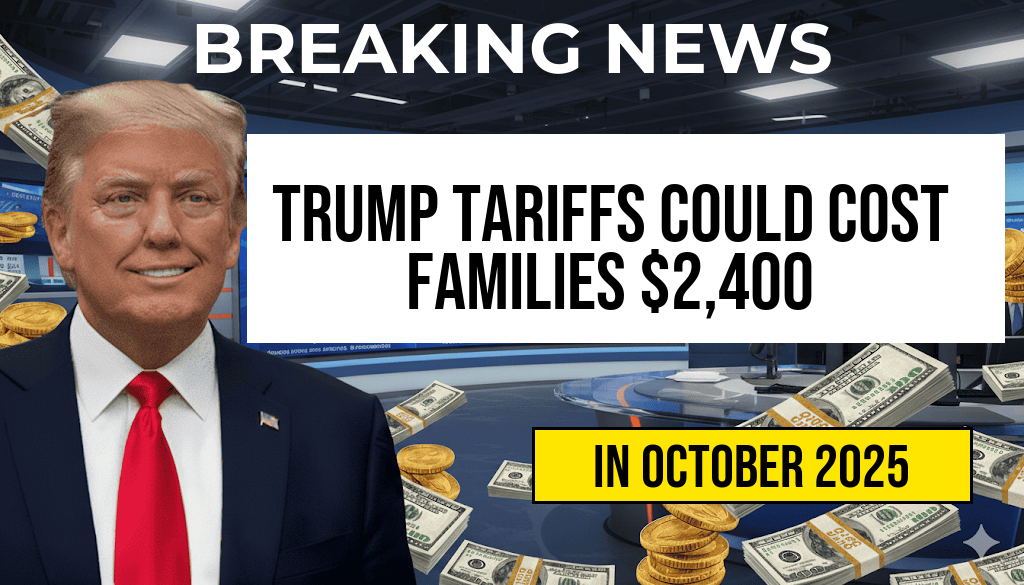Recent adjustments to tariffs under the Trump administration could result in American families facing an average increase of approximately $2,400 annually in their household expenses. Dubbed the “Turbulence Tax” by critics, these tariffs primarily target imports from China and other trading partners, raising costs on a wide array of consumer goods. As policymakers debate the long-term implications, households are beginning to feel the tangible effects through higher prices on everything from electronics to clothing. Experts warn that this shift could accelerate inflationary pressures while reshaping supply chains, impacting both consumers and small businesses across the nation.
Understanding the Scope of the Tariffs and Their Economic Impact
What Are the Trump Tariffs?
The tariffs implemented during the Trump administration were designed to protect U.S. manufacturing by imposing taxes on imported goods. The tariffs targeted a broad range of products, including steel, aluminum, electronics, and agricultural products. While intended to bolster domestic industries, these measures also increased costs along the supply chain, ultimately passing higher prices onto consumers.
How Do Tariffs Translate to Household Expenses?
Economists estimate that the average American family could see an annual increase of about $2,400 in expenses due to these tariffs. This figure accounts for increased prices across various sectors, including:
- Electronics and appliances
- Clothing and footwear
- Food products and beverages
- Building materials and home goods
The ripple effect from tariffs means that even products not directly taxed often carry higher prices, as businesses adjust to increased costs.
Breaking Down the “Turbulence Tax”
Origins of the Term
The term “Turbulence Tax” has emerged in media and economic circles to describe the additional financial burden placed on American households due to trade policies. It reflects the turbulence in supply chains and market stability caused by shifting tariffs, which create unpredictable price swings and economic uncertainty.
Quantifying the Impact on Families
| Family Income Bracket | Estimated Additional Expenses | Major Affected Sectors |
|---|---|---|
| Lower Income | $1,800 – $2,400 | Food, clothing, household goods |
| Middle Income | $2,000 – $2,400 | Electronics, furniture, apparel |
| Upper Income | $2,200 – $2,400 | Luxury goods, imported vehicles |
Broader Economic Considerations
Inflation and Consumer Spending
The tariffs contribute to inflationary pressures, which can erode purchasing power, especially for lower and middle-income families. A rise in consumer prices often leads to reduced discretionary spending, affecting retail sales and overall economic growth.
Supply Chain Disruptions
Manufacturers and retailers face increased costs and logistical challenges due to tariffs, leading to delays and shortages. Small businesses, in particular, may struggle to absorb these costs or find alternative sources, further amplifying the impact on consumers.
Trade Policy and Political Debate
While supporters argue that tariffs protect American jobs and industries, critics contend they bring unnecessary costs to consumers and risk igniting retaliatory tariffs from trading partners. The debate continues to influence policy decisions and market stability.
Looking Ahead: Policy Shifts and Consumer Strategies
Potential Changes in Tariff Policies
As the Biden administration reviews trade policies, some experts anticipate adjustments to tariffs, which could either soften the financial blow or reshape trade negotiations. Monitoring official announcements remains crucial for consumers and businesses alike.
Mitigating the Impact
Families aiming to counteract the “Turbulence Tax” might consider strategies such as shopping for domestically produced goods, leveraging bulk purchasing, or exploring alternative brands to reduce expenses. Awareness of price fluctuations and proactive planning can help ease the financial strain.
For more information on how tariffs influence the economy, visit Wikipedia’s overview of trade tariffs and Forbes’ analysis of tariff impacts.
Frequently Asked Questions
What is the “Turbulence Tax” mentioned in the article?
The “Turbulence Tax” refers to the additional expenses that American families may face due to tariffs imposed during the Trump administration. These tariffs increase the cost of imported goods, leading to higher prices for everyday products.
How much could the “Turbulence Tax” potentially add to my annual expenses?
The article estimates that the “Turbulence Tax” could add up to $2,400 annually to the average family’s expenses, impacting household budgets significantly over the year.
Which types of products are most affected by these tariffs?
Tariffs primarily target imported goods such as electronics, clothing, and household items. These increased costs are often passed down to consumers, making these products more expensive.
How do tariffs influence the overall economy and consumer prices?
Tariffs can lead to increased costs of goods across various sectors, potentially causing inflation and reducing consumers’ purchasing power. This creates a ripple effect that can slow economic growth.
What can families do to mitigate the impact of the “Turbulence Tax”?
Families can consider strategies such as shopping for domestic alternatives, adjusting spending habits, or exploring discounts and promotions to offset the higher costs caused by tariffs and protect their budgets.

Leave a Reply